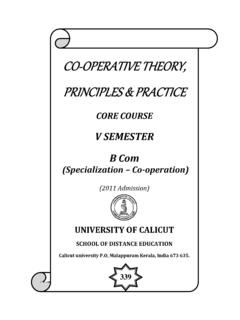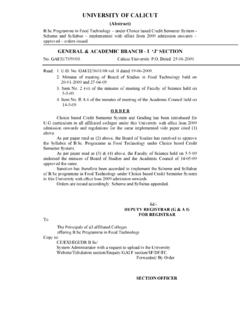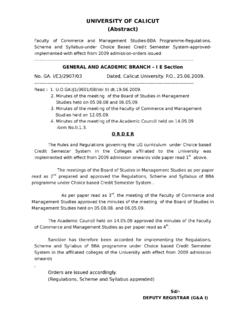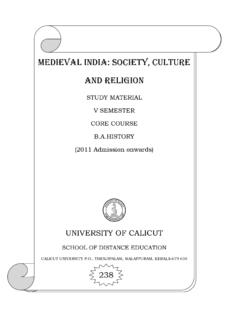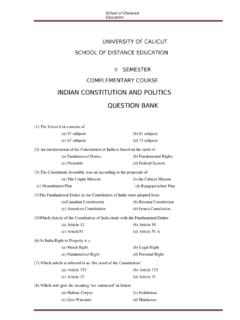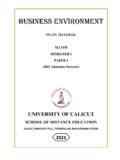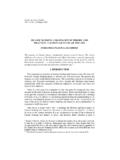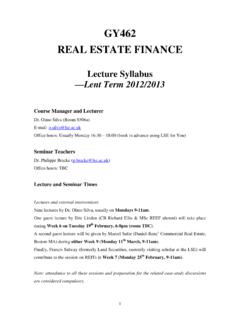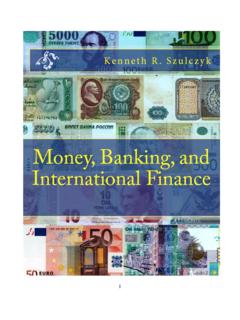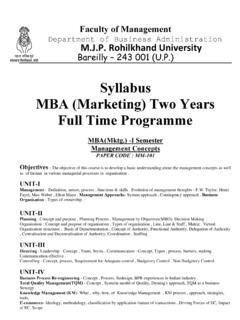Transcription of BANKING AND FINANCE - University of Calicut
1 BANKING AND FINANCEVISEMESTERADDITIONALCOURSE(In lieu of Project)BAECONOMICS(2011 Admission) University OF CALICUTSCHOOL OF DISTANCE EDUCATIONC alicut University , Malappuram Kerala, India 673 of Distance EducationBanking & Finance2 University OF CALICUTSCHOOL OF DISTANCE EDUCATIONSTUDY MATERIALA dditionalCourse(In lieu of Project)BAECONOMICSVIS emesterBANKING AND FINANCEP reparedby:Module I & ,Assistant Professor,PGDepartment of Commerce,Govt. College Kodanchery,Kozhikode ,Assistant Professor,PGDepartment of Commerce,Govt. CollegeKodanchery,Kozhikode Professor,PGDepartment of Commerce,Govt.
2 College Kodanchery,Kozhikode by:Dr. C. KrishnanAssociate Professor,PG Department of Economics,Government College, Kodanchery,Kozhikode 673 :Computer Section, SDE ReservedSchool of Distance EducationBanking & Finance3 CONTENTSPAGE NoMODULEICOMMERCIAL BANKING5 MODULEIIRESERVE BANK OF INDIA21 MODULEIIIMONEY MARKET39 MODULEIVCAPITAL MARKET57 School of Distance EducationBanking & Finance4 SYLLABUSCOURSE TITLE: BANKING AND FINANCEM odule I : Commercial BankingMeaning of Banks Origin and growth Functions of Commercial banks Role ofCommercial Banks in Economic Development Credit Creation Meaning and basic conceptsModule II : Reserve Bank of India (RBI)Management and Structure of RBI-Functions of RBI-Monetary policy-Objectives ofmonetary policy Instruments of Monetary PolicyModule III.
3 Money MarketMeaning of Mone market Constituents of Money market Call money market Collateral Loan market, Acceptance market, Bill market Institutions of Money market Commercial Banks, Central Bank, Acceptance houses, Non- BANKING financial intermediaries Features of Indian Money IV : Capital MarketMeaning and function Components of Capital market Important Financial Instruments Equity shares, Preference shares, Debentures or Bonds The Primary market Methods of PublicIssue IPO Physical shares and Demat shares Stock Exchanges Meaning and functions BSE and NSE Stock Indices in India SENSEX and Nifty DIIs and FIIs Securities andExchange Board of India (SEBI) Role and Maheswari and Paul, Kalyani Publishers, Ludhiana (Recent Edition) Shekhar and Lekshmi Shekhar, BANKING Theory and Practice, Vikas Publishing House Pvt.
4 Ltd,New Delhi ( Recent Edition) , Capital Markets, Vijay Nicole Imprints Pvt. Ltd, Chennai (Recent Edition) , Nisha Agarwal and NeetiGupta, Financial Markets and Institutions, KalyaniPublishers, New Delhi (Recent Edition)Online of Distance EducationBanking & Finance5 MODULEICOMMERCIAL BANKINGE volution of BANKING (Origin and development of BANKING )The evolution of BANKING can be traced back to the early times of human ofbankingbegins with the first prototype banks of merchants of the ancient world, which made grainloans to farmers and traders who carried goods between cities.
5 This began around 2000 BC inAssyria and olden times people deposited their money and valuables at temples, asthey are the safest place available at that time. The practice of storing precious metals at safeplaces and loaning money was prevalent in ancient modern BANKING is of recentorigin. The development of BANKING from the traditionallines to the modern structure passes through Merchant bankers, Goldsmiths, Money lenders andPrivate banks. Merchant Bankers were originally traders in goods. Gradually they started tofinance trade and then become bankers.
6 Goldsmiths areconsidered as the men of honesty, integrityand provided strong iron safe for keeping valuables and money. They issueddeposit receipts (Promissory notes) to people when they deposit money and valuables with goldsmith paid interest on these from accepting deposits, Goldsmiths began tolend a part of money deposited with they became bankers who perform both the basicbanking functions such as accepting deposit and lending money. Money lenders were graduallyreplaced by private banks were established in a more organised growthof Joint stock commercial BANKING was started only after the enactment of BANKING Act 1833 and Growth of BANKING in IndiaIndia has a long history of financial intermediation.
7 The first bank in India to be set up onmodern lines was in 1770 by a British Agency House. The earliest but short-lived attempt toestablish a central bank was in 1773. India was also a forerunner in terms of development offinancial markets. In the beginning of 18thcentury, British East India Company launched a fewcommercial banks. Bank of Hindustan(1770) was the first Indian bank established in India. Lateron, the East India Company started threepresidency banks, Bank of Bengal(1806), Bank ofBombay(1840) and Bank of Madras(1843) These bank were given the right to issue notes in theirrespective regions.
8 Allahabad bank was established in 1865 and Alliance Bank in 1875. The firstbank of limited liability managed by Indians was Oudh Commercial Bank founded in , the Punjab National Bank was established in 1894. In the Beginning of the 20thcentury, Swadeshi movement encouraged Indian entrepreneurs to start many new banks in landmark in the history of Indian BANKING was the formation of Imperial bank of India in1921 by amalgamating 3 presidency banks It is the Imperial Bank which performed some centralbanking functions in India.
9 A number of banks failed during the first half of the 20thCentury. Itaffected the people s belief and faith in of Distance EducationBanking & Finance6By independence, India had a fairly well developed commercial BANKING system inexistence. In 1951, there were 566 private commercial banks in India with 4,151 branches, theoverwhelming majority of which were confined to larger towns and cities. Savings in the form ofbank deposits accounted for less that 1 per cent of national income, forming around 12 per cent ofthe estimated saving of the household sector.
10 The Reserve Bank of India (RBI) was originallyestablished in 1935 by an Act promulgated by the Government of India, but as a shareholderinstitution like the Bank of England. After India's independence, in the context of the need for closeintegration between itspolicies and those of the Government, the Reserve Bank became a state-owned institution from January 1, 1949. It was during this year that the BANKING Regulation Actwas enacted to provide a framework for regulation and supervision of commercial independence, India had a fairly well developed commercial BANKING system inexistence.
